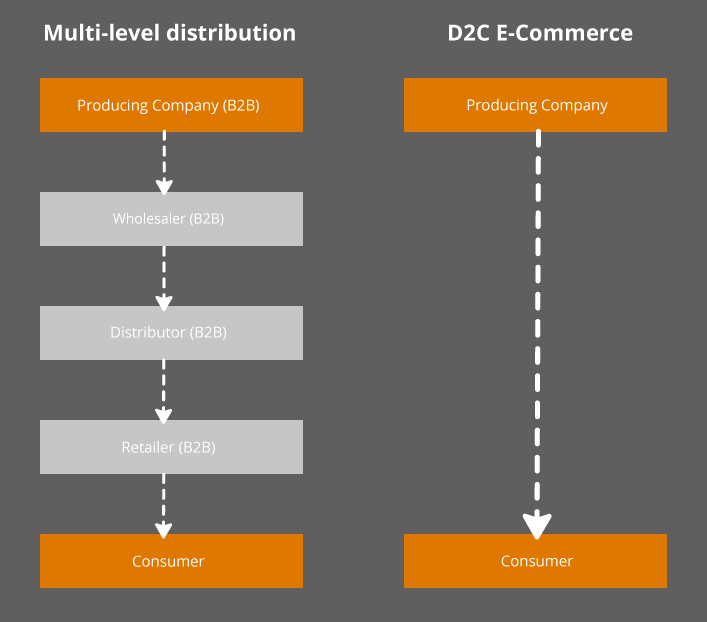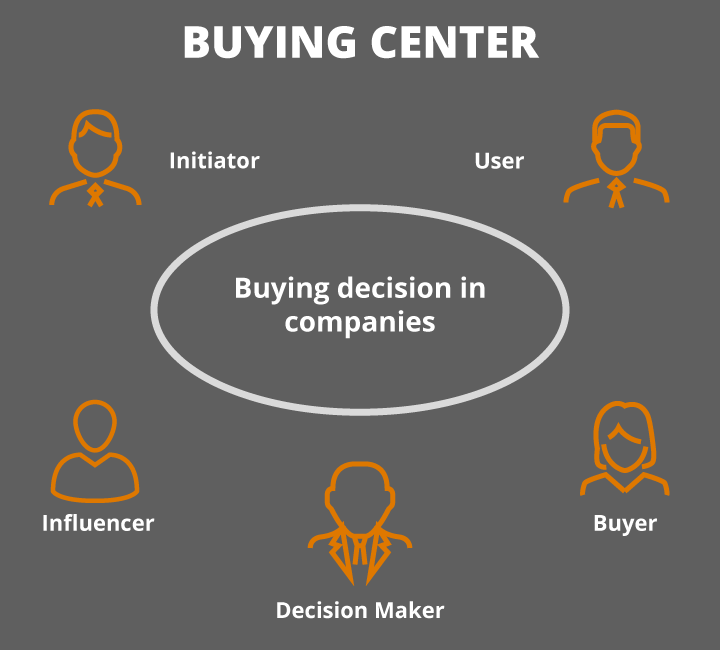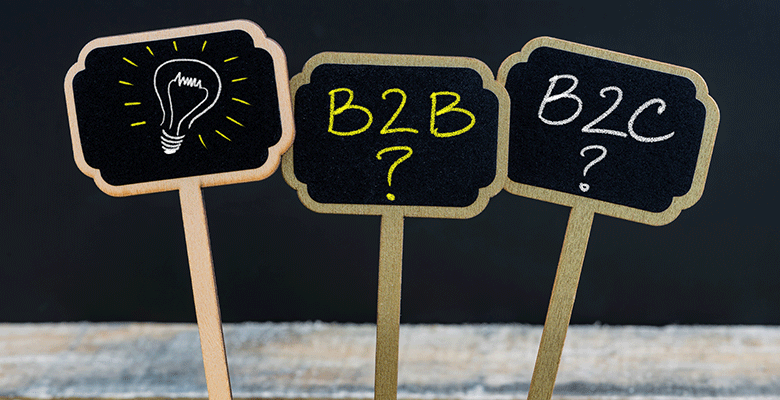Short definition: What does B2B, B2C and D2C mean?
If your company sells products to business customers, you operate in the B2B sector. The acronym stands for business-to-business.
If you sell products that you do not manufacture yourself to private customers, this is referred to as B2C sales. B2C stands for business-to-customer or business-to-consumer.
Direct-to-Consumer or Direct-to-Customer is abbreviated as D2C. Here, manufacturers offer their products directly to private or commercial end customers without intermediaries.


What are the special features of B2C?
In many industries, B2C sales have been established for decades. A producer focuses on the manufacture of its products and virtually outsources sales to the final customer circle consisting of experts.
These experts are, for example, wholesalers, retailers, craftsmen and other sales intermediaries. They have a direct relationship with consumers and take marketing and sales actions to increase their sales, revenue and profit. And distributors know the ins and outs of this model:
- Sales intermediaries determine how they distribute the producer's products - for example, through retail stores, their own online stores, or online marketplaces.
- Many B2C products can be sold quite quickly. This is due, for example, to the fact that the consumer goods are very inexpensive or at least do not represent a large investment. The customer journey is usually short or at least manageable for chewing gum, shelves, or even smartphones.
- In addition, most consumers make their decisions alone or at least in a small circle. Rarely is any kind of committee needed to make a purchase.
- Another special feature is that modern private customers are very digital. They look for information on websites, video portals, social networks and compare prices in various online stores. This is where the ROPO effect sets in: The consumer researches online, but buys offline - and vice versa.
- One disadvantage of the B2C model is that margins are usually quite low. Accordingly, it is important to continuously trim all structures and processes for efficiency.
B2B: What characterizes this sales model?
The business-to-business sector is not homogeneous either. On the one hand, craft businesses buy a few thousand new screws from a specialist for just a few euros; on the other hand, they purchase special machines that cost tens of thousands. The amounts are even higher for industrial companies: A printing press or a paint shop run into hundreds of thousands or millions.
This is exactly where the special features of B2B come into play:
- When large expenses are due, the customer journey can be very long. Understandably so. You just don't buy 20 new excavators overnight. The decision should be well weighed. After all, a company may have to take out a loan for the investment.
- In addition, the purchasing decision is never made alone, especially in the case of large to very large investments. In companies, a so-called buying center is formed. This is a group of people consisting of various participants - for example, project managers, buyers, controllers and the management.


- In B2B, price negotiations are common. These can last for weeks or months. Each customer often receives individually negotiated prices with special conditions or additional services. Graduated prices based on the sales volume are also common.
- Some business customers - still - act quite classically. This means that they visit trade shows, browse through catalogs, read industry-specific trade magazines, interact with sales representatives, and negotiate directly with salespeople.
- But a radical change has been taking place for a few years: There are also webinars and online trade shows in B2B, and target groups consume online magazines and use social networks. In addition, B2B online stores and marketplaces are booming, where suppliers from faraway countries, among others, offer their products and services.
That’s why D2C is so on trend
If your company manufactures products and brings them to end customers via sales intermediaries, this has one major advantage: you can focus on the essentials - product development and production. In return, your profit margin is reduced.
But the Corona pandemic at the latest has shown that established and supposedly strong distribution structures can quickly collapse. When stores are closed and supply chains are interrupted, nothing gets sold. By entering the direct-to-consumer business, you can cushion this malus.
- If your company distributes its products directly to customers, you are less dependent on the structures of your sales intermediaries. You can determine how sales and marketing are organized.
- If you distribute your products without an intermediary, you don't give away any margin. In the end - at least in theory - more remains with your company.
- In practice, however, D2C means: your company has to develop its own marketing and sales strategy and implement suitable measures to reach consumers directly. This can be very costly and time-consuming. Especially since you have to build up know-how internally in the form of new specialists.
- In addition, you need an adapted sales structure and new sales channels. For example, you should invest in your own online store and/or offer your products yourself via online marketplaces.
- Your investment is rewarded with another benefit: You establish a direct line to the users of your products. In this way, you can gather feedback: You learn firsthand what is good or bad about your offerings and what changes consumers would like to see.
Tips for e-commerce in B2B, B2C and D2C
You want to build an online store to sell your products online? A very good idea! But first, define exactly to whom and how you want to sell. And follow these tips during the implementation:
- Private end customers appreciate being able to pay quickly and easily in an online store. Therefore, offer common payment methods such as purchase on account, PayPal, Klarna and credit card.
- In B2B, invoicing is considered common. The business customers repay the amount within a negotiated period by bank transfer, discount is common for a quick transfer.
- In B2C, there is no online negotiation. The prices as listed in the online store apply. Volume discounts are also unusual.
- Quite different in B2B: A business customer online store should offer the possibility for graduated prices and individual discounts.
- In a B2C online store, every user is virtually the same. Not in B2B! Here, there are accounts with different rights. For example, a craftsman can use his login to add products to the shopping cart, but only someone from the purchasing department can negotiate prices and make the final purchase.
- As a producer, you have different IT structures than a retailer, for example. You should definitely take this into account when implementing your e-commerce platform. You may want to connect systems such as ERP, WaWi, CRM or PIM to your online store in order to exchange real-time data and accelerate processes.
- Never underestimate the marketing effort! If your company has "only" been a producer so far and is now entering D2C, you will need a decent marketing budget and sufficient internal resources to push the marketing of your online store.
- The closer you get to your end customers, the more you should try to engage in direct exchange. Try to gather as much feedback as possible via online reviews, surveys, newsletters, and the like. Use the opportunity to find out more about the wishes and needs of your target groups.
Finally: Don’t forget H2H!
H2H is not a new distribution model. Instead, H2H stands for human-to-human. This means that whether you are active in B2B, B2C or D2C, always remember that you are interacting with people.
Every human or consumer wants to read understandable product info, view great product photos and videos, and have a quick, easy buying process. Amazon has been demonstrating how smooth and convenient e-commerce can be for consumers for many years.
Thus: Don't make it unnecessarily complicated! Simplify and streamline your processes. Turn all the screws, because the demands of customers are growing day by day. If an online store is too slow, important information is missing, or the purchasing process is cumbersome, you'll scare away (potential) customers.
Always be aware that your competitors are only a few clicks away - and your target groups know that too!








